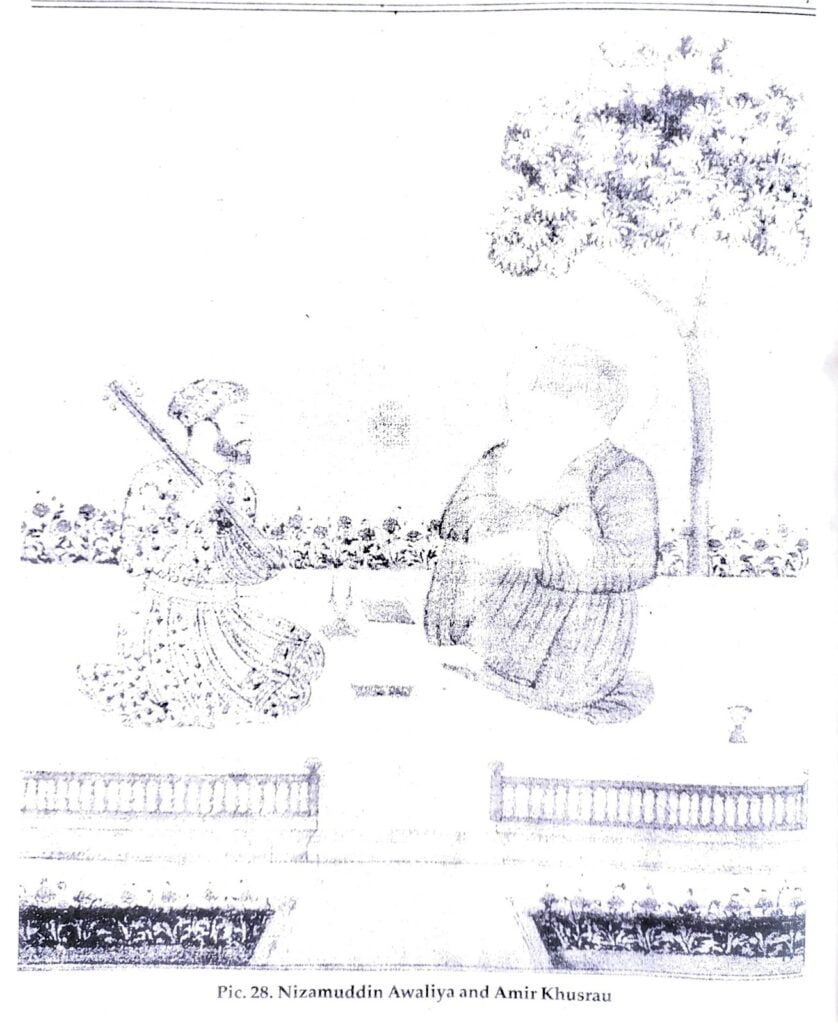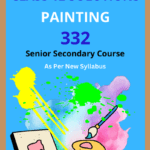NIOS Class 12 Painting Chapter 10 Deccan School of Painting Solutions to each chapter is provided in the list so that you can easily browse throughout different chapters NIOS Class 12 Painting Chapter 10 Deccan School of Painting and select need one. NIOS Class 12 Painting Chapter 10 Deccan School of Painting Question Answers Download PDF. NIOS Study Material of Class 12 Painting Notes Paper 332.
NIOS Class 12 Painting Chapter 10 Deccan School of Painting
Also, you can read the NIOS book online in these sections Solutions by Expert Teachers as per National Institute of Open Schooling (NIOS) Book guidelines. These solutions are part of NIOS All Subject Solutions. Here we have given NIOS Class 12 Painting Chapter 10 Deccan School of Painting, NIOS Senior Secondary Course Painting Solutions for All Chapter, You can practice these here.
Deccan School of Painting
Chapter: 10
PAINTING
Nizamuddin Awaliya and Amir Khusrau (Pic. 28)
| Medium | water colour on hand-made paper |
| Period | circa 18th C.A.D |
| Size | 29×22cm. |
| Style | Hyderabadi school |
| Artist | Unknown |
| Technique | Tempera |
| Collection | National Museum, New Delhi |
The Sufi Saint Nizam-ud-din Aulia is shown Sufi song from his disciple Amir Khusru. The halo around the head of the Saint shows his spiritual attainment and wisdom. A serene and peaceful atmosphere is created by the painter by painting a garden and single tree in the background. The facial expression and posture of the body of Nizamud-din give the impression that he is deeply enjoying the music.
Tanjore Painting
| Title | Goddess Saraswati |
| Medium | Water colors on board with semi-precious gems/ Mix-Medium |
| Date | 19th century |
| Size | 28.5x22cm. |
| Style | Tanjore school |
| Artist | Chitra gara Krishan Appa |
| Collection | National Gallery of Modern Art, New Delhi |
Tanjore paintings are different from any other painting style because of its embellishment over the basic drawing with precision and semi- precious stone as well as the relief work.
This art originated in Thanjavoor (Tanjore) in Tamil Nadu during 16th C.AD., but most of the extant works belong to 19th C.A.D. This style became famous in the surrounding regions, and spread all over the Deccan. The popular theme have been Krishna, Radha, Vishnu and Ganesha.
This is a painting of Devi Saraswati, the goddess of learning seated on a throne. She has four arms. She is shown playing a “Veena.” The painting is highly ornamental and colourful. Classical Indian motifs are used with very fine details.
Intext Questions 10.1
Choose the right answer:
1. One of the paintings of Deccan School show the famous pair of Guru and disciple like
(a) Guru Nanak and Mardana.
(b) Nizam-du-din and Amir Khusru.
(c) Ravidas and Kabir.
Ans: (b) Nizam-du-din and Amir Khusru.
2. The style of this painting belongs to
(a) Tanjore school.
(b) Hyderabadi school.
(c) Bijapur school.
Ans: (b) Hyderabadi school.
3. The painting’s date is
(a) 8th C.A.D
(b) 19th C.A.D
(c) 18th C.A.D
Ans: (c) 18th C.A.D


Intext Questions 10.2
Choose the right answer:
1. Tanjore paintings are different because of its
(a) embelishment with gems.
(b) lines and colours.
(c) themes.
Ans: (a) embelishment with gems.
2. This art originated in
(a) Vijaya nagar.
(b) Tamil Nadu.
(c) Gujarat.
Ans: (b) Tamil Nadu.
3. The enlisted paintings of Saraswati is decorated with
(a) Persian motifs.
(b) Western motifs.
(c) Indian classical mitifs.
Ans: (c) Indian classical mitifs.
Model Questions
1. How did Deccan art flourish during the medieval period?
Ans: The plateau region in South India between the Narmada river and Krishna river is called Deccan. This region continued the indigenous Hindu tradition under the powerful rule of the Vijayanagar kings, while Muslims dynasty were ruling the Northern part of India during 14th C.A.D. Heritage of the painting style is rooted both in the Deccan and South. Nagara, Bijapur and Golcanda style of painting are also rooted in this region. All these painting style shared the stylistic features with painting traditions of Western and Northern Indian. The Tanjore school of Painting, on the other hand, develop an original style with a difference.
2. Describe the theme of the enlisted painting from Hyderabad.
Ans: In this painting the sufi Saint Nizam- ud-din Aulia is enjoying a Sufi song from his disciple Amir Khusru. The halo around the head of the Saint expresses his spiritual attainment and wisdom. A serene and peaceful atmosphere is created by the painter with a garden and sing tree in the background. The facial expression and posture of the body of Nizamud-din give the impression that he is lost deeply into the music.
3. Why Tanjore painting is different from other schools of painting?
Ans: This art originated in Thanjavur (Tanjore) in Tamil Nadu during 16th C.AD., but most of the extant works belong to 19th C.A.D. This style became very popular in the surrounding regions, and spread all over the Deccan. The popular theme had been Krishna, Radha, Vishnu and Ganesha.
Very Short Type Questions Answer
1. Under which ruler Deccan school of painting flourish?
Ans: The Deccan school of painting flourished under the Bahmini ruler in the Deccan.
2. Which other painting styles are rooted in the Deccan style of painting?
Ans: Nagara, Bijapur and Golconda style of painting are rooted in the Deccan style of painting.
3. Which painting of the southern Indian developed an original style with a difference?
Ans: The Tanjore school of painting.
4. What technique is used in Nizamudin Awaliya and Amir Khusrau painting?
Ans: Tempera.
5. What is Nizam-ud-din doing in the painting?
Ans: The Sufi Saint Nizam-ud-din Aulia is- enjoying a sufi song from his disciple Amir Khusru.
6. How is spiritual attainment and wisdom shown in the painting Nizamuddin Auliya and Amir Khusrau?
Ans: The halo around the head of the saint expresses his spiritual attainment and wisdom.
7. Who painted the painting “GoddessSaraswati”?
Ans: Chitra gara Krishna Appa.
8. What were popular themes of Tanjore painting?
Ans: Krishna, Radha, Vishnu and Ganesha.
9. What type of medium is used in the painting “Goddess Saraswati”?
Ans: Water colour on board with semi-precious gems/mix-medium.
10. What instrument is Goddess Saraswati playing in the painting?
Ans: Veena.
Short Type Questions Answer
1. Describe the painting Nizamudin Awaliya and Amir Khusrau?
Ans: In this painting, the sufi Saint Nizam- ud-din Aulia is enjoying a Sufi song from his disciple Amir Khusru. The halo around the head of the Saint expresses his spiritual attainment and wisdom. A serene and peaceful atmosphere is created by the painter with a garden and single tree in the background. The facial expression and posture of the body of Nizamud-din give the impression that he is lost deeply into the music.
2. How did Tanjore painting originate?
Ans: This art originated in Thanjavur (Tanjore) in Tamil Nadu during 16th C.AD., but most of the extant works belong to 19th C.A.D. This style became very popular in the surrounding regions, and spread all over the Deccan. The popular theme have been Krishna, Radha, Vishnu and Ganesha.
3. How is Devi Saraswati described in the “Goddess Saraswati” painting?
Ans: In this painting of Devi Saraswati, the goddess of learning is seating on a throne. She has four arms. She is playing a “Veena”. The painting is highly ornamental and colourful. Classical Indian motifs are used with very minute details.
4. Describe the Tanjore painting by giving an example:
Ans: Tanjore paintings are different from any other painting style because of its embellishment over the basic drawing with precious and semi-precious stone as well as the relief work.
This art originated in Thanjavoor (Tanjore) in Tamil Nadu during 16th C.AD., but most of the extant works belong to 19th C.A.D. This style became very popular in the surrounding regions, and spread all over the Deccan. The popular themes had been Krishna, Radha, Vishnu and Ganesha.
This is a painting of Devi Saraswati, the goddess of learning seating on a throne. She has four arms. She is playing a “Veena”. The painting is highly ornamental and colorful.
Classical Indian motifs are used with very minute details.

Hi! my Name is Parimal Roy. I have completed my Bachelor’s degree in Philosophy (B.A.) from Silapathar General College. Currently, I am working as an HR Manager at Dev Library. It is a website that provides study materials for students from Class 3 to 12, including SCERT and NCERT notes. It also offers resources for BA, B.Com, B.Sc, and Computer Science, along with postgraduate notes. Besides study materials, the website has novels, eBooks, health and finance articles, biographies, quotes, and more.



